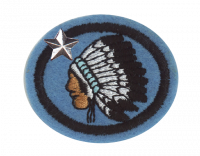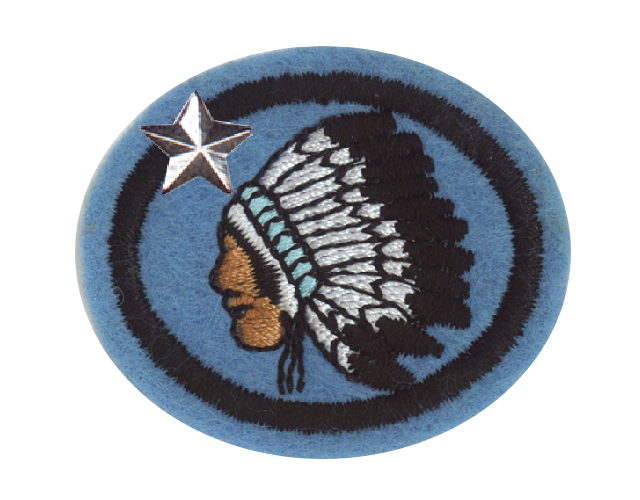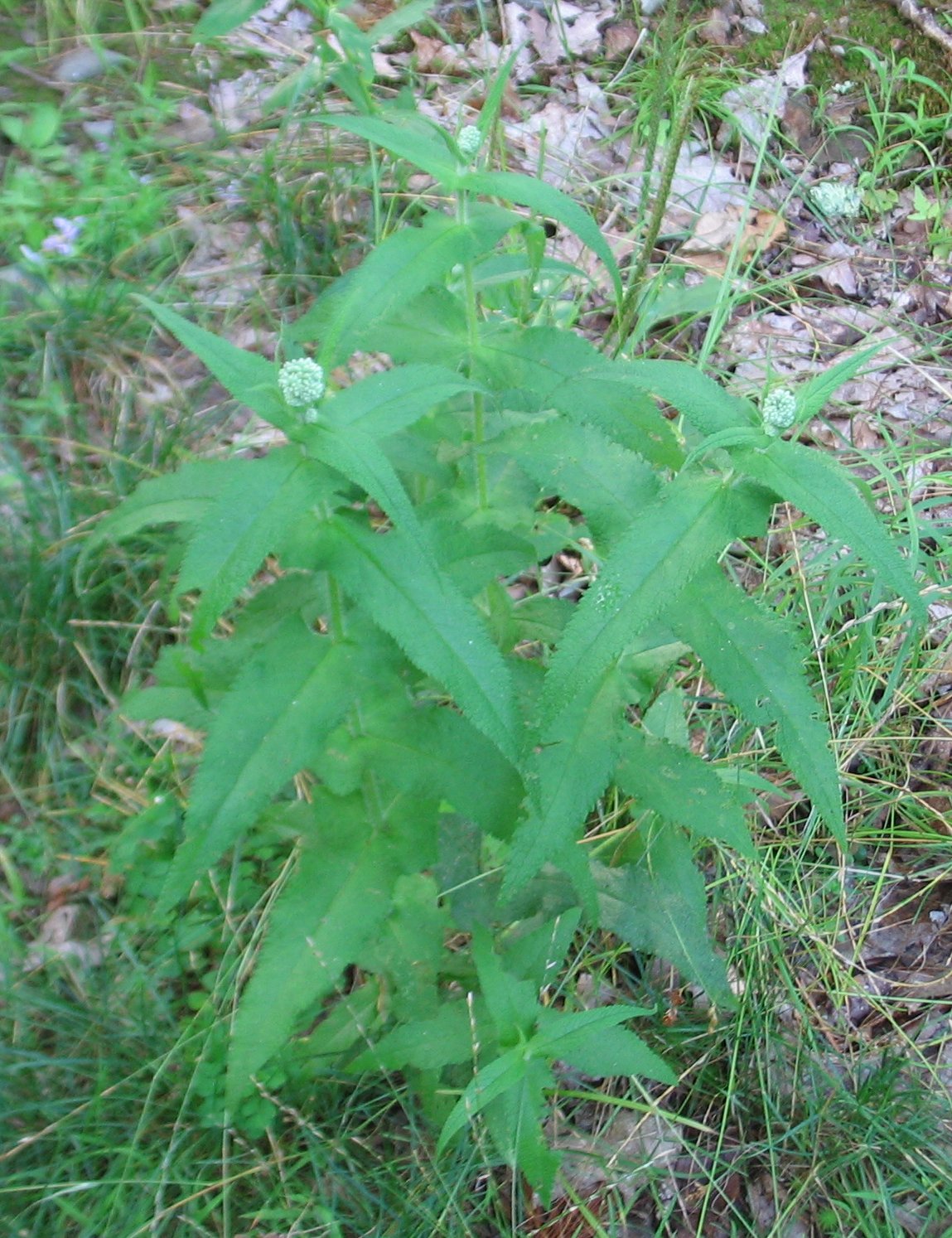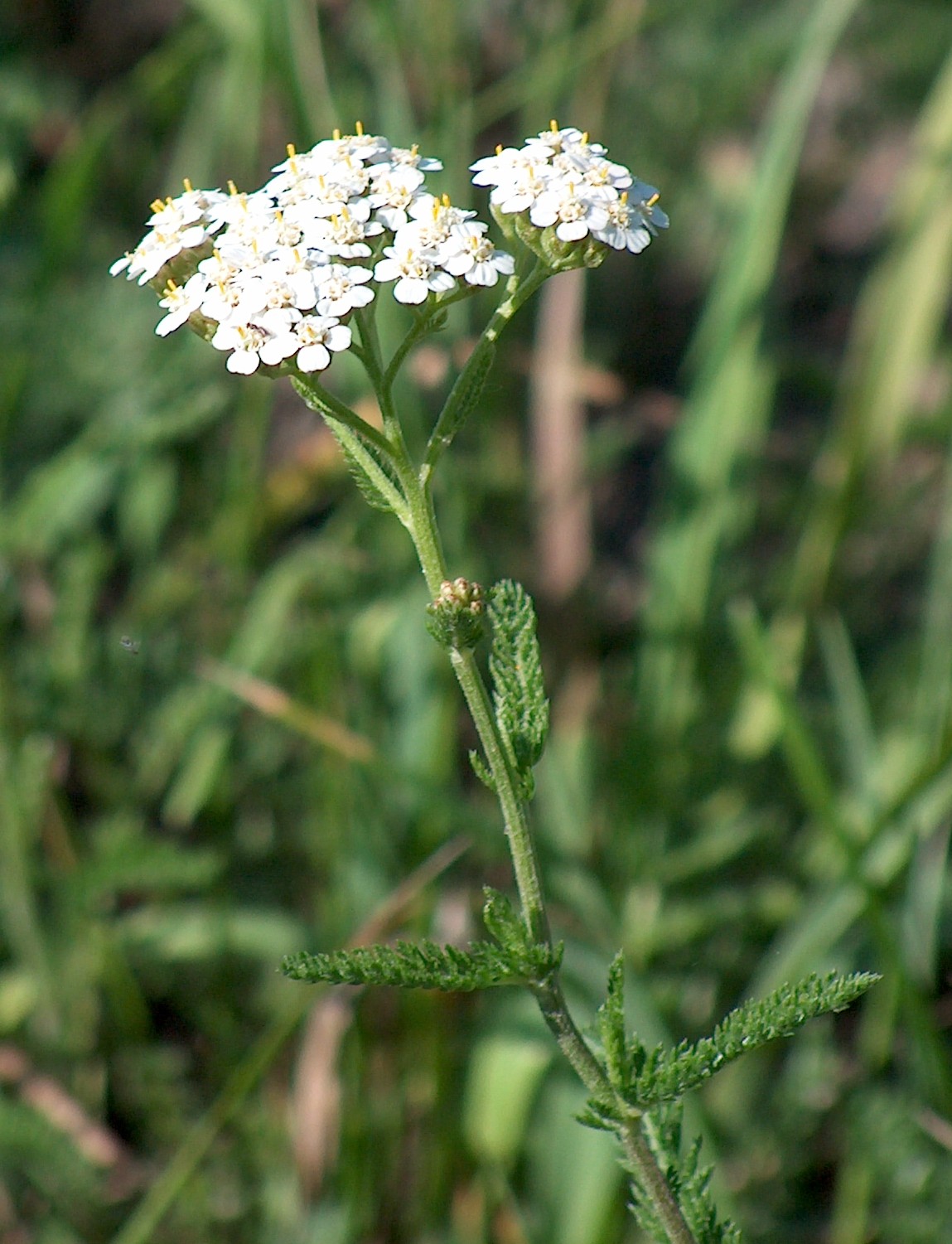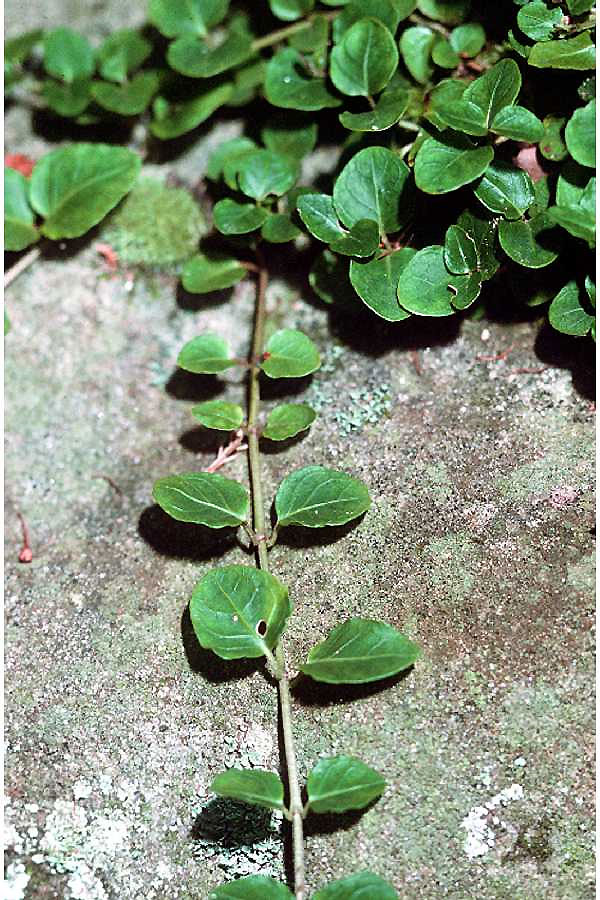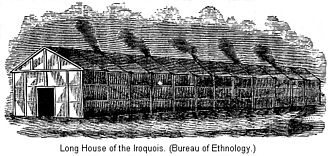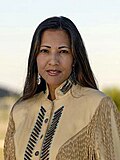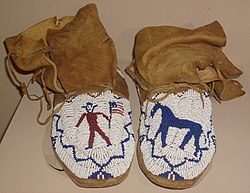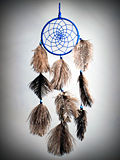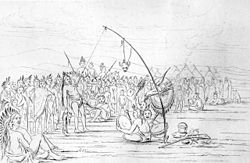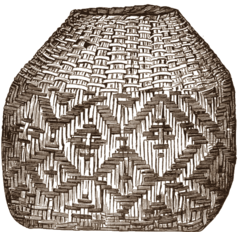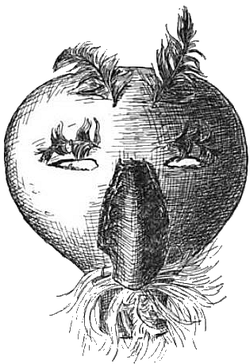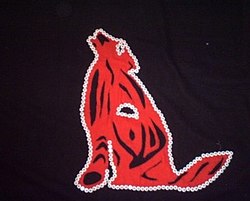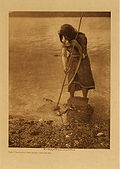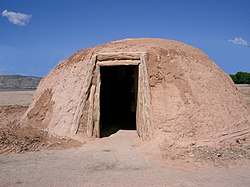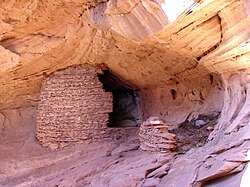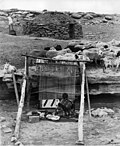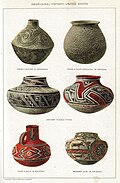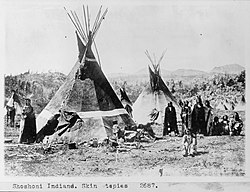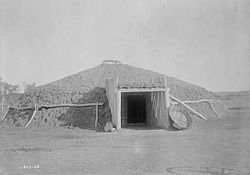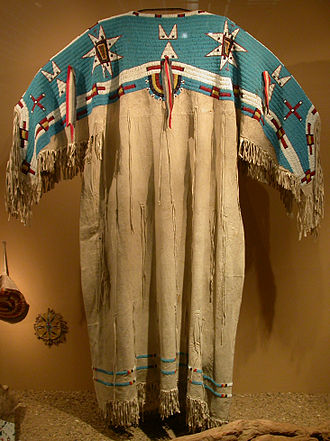Difference between revisions of "AY Honors/Native American Lore - Advanced/Answer Key/es"
(Created page with "</noinclude> <!-- 1. Tener la especialidad de Artes y trabajos indígenas. --> {{honor_prerequisite|display=Artes y trabajos indígenas|honor=Native American Lore}}") |
(Created page with "</noinclude> <!-- 3. Participar en una comida utilizando la mayor cantidad de alimentos y métodos de cocción indígena como sean posibles. -->") |
||
| Line 16: | Line 16: | ||
{{CloseReq}} <!-- 2 --> | {{CloseReq}} <!-- 2 --> | ||
{{ansreq|page={{#titleparts:{{PAGENAME}}|2|1}}|num=3}} | {{ansreq|page={{#titleparts:{{PAGENAME}}|2|1}}|num=3}} | ||
| − | <noinclude> | + | <noinclude></noinclude> |
| − | </noinclude> | + | <!-- 3. Participar en una comida utilizando la mayor cantidad de alimentos y métodos de cocción indígena como sean posibles. --> |
| − | <!-- 3. | ||
| − | |||
| − | |||
<div lang="en" dir="ltr" class="mw-content-ltr"> | <div lang="en" dir="ltr" class="mw-content-ltr"> | ||
Revision as of 16:16, 2 May 2021
Nivel de destreza
2
Año
1976
Version
02.12.2025
Autoridad de aprobación
Asociación General
1
Para consejos e instrucciones, véase Artes y trabajos indígenas.
2
3
Hominy Grits
Adventist Youth Honors Answer Book/Recipes/Hominy Grits
Acorn Mush
Adventist Youth Honors Answer Book/Recipes/Acorn mush
Hoecake
Adventist Youth Honors Answer Book/Recipes/Hoecake
Wojape
Adventist Youth Honors Answer Book/Recipes/Wojape
Succotash
4
We do not recommend that you attempt to treat any sicknesses using the plants listed here. Doing so could certainly endanger your health.
Boneset
Descripción: Eupatorium perfoliatum or boneset is a common perennial plant native to the Eastern United States and Canada. It is also called "agueweed", "feverwort" or "sweating-plant". The plant grows about 1m tall, with leaves that clasp the stems and dense clusters of white heads held above the foliage.
Dónde se encuentra: Nova Scotia to Florida, as well as from Louisiana and Texas through North Dakota.
Uso: It was introduced to American colonists by Indians who used the plant for breaking fevers by means of heavy sweating.
Willow
Descripción: The willows all have abundant watery juice, furrowed scaly bark which is heavily charged with salicylic acid, soft, pliant, tough wood, slender branches and large fibrous roots. These roots are remarkable for their toughness, size, and tenacity of life.
Dónde se encuentra: Found primarily on moist soils in cold and temperate regions of the Northern Hemisphere.
Uso: The leaves and bark of the willow tree have been used as a remedy for aches and fever by many cultures. Native Americans across the American continent relied on it as a staple of their medical treatments.
Common Yarrow
Descripción: Common Yarrow (Achillea millefolium) is an erect herbaceous perennial plant that produces one to several stems (0.2 to 1m tall). Leaves are evenly distributed along the stem, with the leaves near the middle and bottom of the stem being the largest. The leaves have varying degrees of hairiness. The leaves are 5-20 cm long, bipinnate or tripinnate, almost feathery, and arranged spirally on the stems.
Uso: The herb is purported to be a diaphoretic, astringent, tonic, stimulant and mild aromatic. It contains isovaleric acid, salicylic acid, asparagin, sterols, flavonoids, bitters, tannins, and coumarins. The plant also has a long history as a powerful 'healing herb' used topically for wounds, cuts and abrasions. Navajo Indians consider it to be a "life medicine", and chewed it for toothaches, and poured an infusion into ears for earaches.
Wintergreen
Descripción: Wintergreen is low-growing, typically reaching 10–15 cm tall. The leaves are evergreen, elliptic to ovate, 2–5 cm long and 1–2 cm broad, with a distinct oil of wintergreen scent. The flowers are bell-shaped, 6–8 mm long, white, borne solitary or in short racemes. The fruit is an edible red berry 8–15 mm diameter.
Dónde se encuentra: Eastern U.S. and Canada
Uso: Wintergreen contains methyl salicylate, which was used by Native Americans to bring down fever and as a pain killer.
Partridge berry
Descripción: This evergreen plant is a creeping, but not climbing, vine, 15-30 cm long. The evergeen dark-green leaves are opposite, ovate to cordate, with a pale yellow midrib. The petioles are short. Roots may grow at the internodes, forming loose mats. It is part of the undergrowh vegetation in many forests.
Dónde se encuentra: The species is dispersed throughout eastern North America
Uso: A tea brewed from partridge berry was given to women in the last two weeks of their pregnancies to ease childbirth.
5
- a. Tribus localizados allí
- b. Hogares y las prendas de vestir
- c. Artesanía nativa realizada como: cestería, cerámica, alfombras, etc.
- d. Las prácticas religiosas
- e. Forma de gobierno
The four divisions of Northeast, Southeast, Northwest, and Southwest are not really the best way to categorize Native American culture, as it excludes some major cultural societies that do not fit neatly into these four categories. In addition to these four, we also present the culture of the Plains Indians. Cultures from California, the Great Basin, the Plateau, Arctic, and Subarctic regions of North America could also be included.
Northeast
Tribes
Algonquian tribes of the New England area include Mohegan, Pequot, Narragansett, Wampanoag, Massachusett, Nipmuck, Pennacook, and Passamaquoddy. The Abenaki tribe is located in Maine and eastern Quebec. These tribes practiced some agriculture. The Maliseet of Maine, Quebec and New Brunswick, and the Mi'kmaq tribes of the Canadian Maritime provinces lived primarily on fishing. Further north are the Betsiamites, Atikamekw, Algonkin and Montagnais/Naskapi (Innu). The Beothuk people of Newfoundland are also believed to have been Algonquians, but they disappeared in the early 19th century and few records of their language or culture remain. In the west, Ojibwe/Chippewa, Ottawa, Potawatomi, and a variety of Cree groups lived in Minnesota, Wisconsin, Upper Michigan, Western Ontario and the Canadian Prairies. In the Midwest lived the Shawnee, Illiniwek, Kickapoo, Menominee, Miami, and Sac and Fox, many of whom have since been displaced over great distances through Indian removal. In the mid- and south-Atlantic are the traditional homes of the Powhatan, Lumbee, Nanticoke, Lenape (Munsee and Unami speakers), and Mahican peoples.
Homes
A typical wigwam in the Northeast has a curved surface which can hold up against the worst weather. The male of the family was responsible for the framing of the wigwam. Young green tree saplings, of just about any type of wood, about ten to fifteen feet long were cut down. These tree saplings were then bent by stretching the wood. While these saplings were being bent, a circle was drawn on the ground. The diameter of the circle varied from ten to sixteen feet. The bent saplings were then placed over the drawn circle, using the tallest saplings in the middle and the shorter ones on the outside. The saplings formed arches all in one direction on the circle. The next set of saplings was used to wrap around the wigwam to give the shelter support. When the two sets of saplings were finally tied together, the sides and roof were placed on it. The sides of the wigwam were usually bark stripped from trees.
Longhouses were built by native peoples in various parts of North America, sometimes reaching over 100 meters long (330 feet) but generally around 5 to 7 meters wide (16-23 ft). The construction method was also different: the dominant theory is that walls were made of sharpened and fire-hardened poles (up to 1,000 saplings for a 50 meter house) driven into the ground {?} had a roof of leaves and grass. Strips of bark were then woven horizontally through the lines of poles to form more or less weatherproof walls with doors usually in one end of the house, although doors also were built into sides of especially long longhouses.They were long and had fireplaces that kept them warm.
Clothing
Buckskins are clothing, usually consisting of a jacket and leggings, made from buckskin, a soft sueded leather from the hide of deer or elk. Buckskins are often trimmed with fringe (originally a functional detail, to allow the garment to dry faster when it was soaking wet because the fringe acted as wicks to soak away the water, or quills.
A moccasin is a shoe made of deerskin or other soft leather, consisting of a sole and sides made of one piece of leather, stitched together at the top, and sometimes with a vamp (additional panel of leather). The sole is soft and flexible and the upper part often is adorned with embroidery or beading, et cetera.
Crafts
Religious Practices
A Sundance was a ceremony in which a medicine man would pierce the skin of a young man's chest and pass a skewer of bone through the piercing. A rope was attached to the skewer on one end, and a tall pole on the other. The brave would then attempt to free himself by pulling away from the pole until the skin tore.
Jingle dress is a dance dress worn by women participating in the "Jingle Dress Dance" at a Pow wow. Made of cloth, the dress includes several rows of metal cones, which are sewn across the dress on the skirt (and blouse, in some areas). The metal cones create a jingling sound as the dancer moves. The Jingle Dress Dance is characterized by the jingle dress and light footwork danced close to ground. The dancer dances in a snake-like pattern around the drum; her feet never cross, nor does she dance backward or turn a complete circle.
Government
Gayanashagowa or the Great Law of Peace of the Iroquois (or Haudenosaunee) Six Nations is the oral constitution that created the Iroquois Confederacy. The law was developed by a man known as The Great Peacemaker and his spokesman Hiawatha. Member Nations ratified this constitution near present day Victor, New York.
The Iroquois Confederacy was once thought to have started in the 1500s, but more recent estimates date the confederacy, and its constitution between 1090 and 1150 CE. These estimates were based on the records of the confederacy leadership and astronomical dating related to a total solar eclipse that coincided with the founding of the Confederacy.
According to several historians, including Donald Grinde, the democratic ideals of the Gayanashagowa, which had been quite unknown in European feudal tradition, provided a significant inspiration to Benjamin Franklin, James Madison and other framers of the United States Constitution. John Rutledge of South Carolina in particular is said to have read lengthy tracts of Iroquoian law to the other framers, beginning with the words "We, the people, to form a union, to establish peace, equity, and order..." The Congress of the United States passed Concurrent Resolution 331 in October 1988, specifically recognizing the influence of the Iroquois Constitution upon the US Constitution and Bill of Rights.
Southeast
Tribes
The tribes of the Southeast included the Adai, Alabama, Apalachee, Caddo, Calusa, Catawba, Cherokee, Chickasaw, Choctaw, Muscogee (Creek), Natchez, Pascagoula, Seminole, Tuscarora, Yazoo, Yemmassee and literally hundreds of others (feel free to expand this list).
Homes
The Apalachee built houses covered with palm leaves or the bark of cypress or poplar trees.
Clothing
- Apalachee
- The Apalachee men wore a deerskin loincloth. The women wore a skirt of Spanish moss or other plant fibers.
- Choctaw
- The colorful dresses worn by today's Choctaw are made by hand and adapted from 19th century European-American designs. Choctaws today wear Choctaw clothing mainly for special events. Choctaw elders, especially the Choctaw women, dress in their traditional garb every day. Choctaw dresses are trimmed by full diamond, half diamond or circle and crosses that represent stickball sticks.
- Muscogee
- Ancestral Muscogee peoples wore clothing made of woven plant materials or animal skins, depending upon the climate. During the summer, they preferred lightweight fabrics woven from tree bark, grasses or reeds. During the harsh winters, animal skins and fur were used for their warmth. During the 1600’s the influence of European fashion became apparent in Southeastern clothing styles. Cloth was more comfortable and colorful than buckskin and quickly became a popular trade item throughout the region. Bolts of cloth could be obtained in a variety of patterns and textures, and allowed an individualized style of dress to grow and change. Muscogee people were soon incorporating trade novelties and trinkets such as bells, ribbons, beads and pieces of mirror.
- Apalachee
- The Apalachee made pottery, wove cloth and cured buckskin.
- Calusa
- Between 500 and 1000 the undecorated sand-tempered pottery that had been common in southern Florida was replaced by "Belle Glade Plain" pottery, which was made with clay containing spicules from freshwater sponges (Spongilla), and which first appeared inland in sites around Lake Okeechobee. This change may have resulted from migration from the interior to the coastal region, or may reflect trade and cultural influence. There was little change in the pottery tradition after this. The Calusa were descended from people who had lived in the area for at least 1000 years prior to European contact, and possibly for much longer than that.
- Catawba
- In the Carolinas, the Catawbas became well-known for their pottery, especially around the Charleston area. Some cooks believed that certain dishes, such as okra soup, could not be prepared properly without a pot made by the Catawbas.
- Choctaw
- The Choctaws are basket & beadwork makers, dancers & musicians, and cuisine specialist, all of which are part of the collective Choctaw culture that defines them as a distinct cultural group.
Religious Practices
- Calusa; The Calusa believed that three supernatural people ruled the world, that people had three souls, and that souls migrated to animals after death. The most powerful ruler governed the physical world, the second most powerful ruled human governments, and the last helped in wars, choosing which side would win. The Calusa believed that the three souls were the pupil of a person's eye, his shadow, and his reflection. The soul in the eye's pupil stayed with the body after death, and the Calusa would consult with that soul at the graveside. The other two souls left the body after death and entered into an animal. If a Calusa killed such an animal, the soul would then migrate to a lesser animal, and eventually be reduced to nothing. Calusa ceremonies included processions of priests and singing women. The priests wore carved masks, which were at other times hung on the walls inside a temple. Hernando de Escalante Fontaneda, an early chronicler of the Calusa, described "sorcerers in the shape of the devil, with some horns on their heads" who ran through the town yelling like animals for four months at a time. The Calusa remained committed to their belief system in the face of Spanish attempts to convert them to Catholicism. The "nobles" resisted conversion in part because their power and position were locked into the belief system; conversion would have destroyed the source of their authority and legitimacy. The Calusa were able to resist the Spanish and their missionaries for almost 200 years, until the tribe was destroyed by Creek and Yemassee raiders early in the 18th century.
- Catawba
- The Catawba religion has a creator (Manatou), and sometimes is said to have a trinity. This trinity consists of Manatou, the creator, Kaia, the turtle, and a third being who is sometimes said to be the son of Manatou. It is likely that the three beings have always been deities in Catawba culture, but that Christian influence has changed Catawba stories so that the three beings are more like the trinity in the Christian religion.
- Cherokee
- The Cherokee revered the Great Spirit, called the Yowa (a name so sacred that only a priest could say it), who presided over all things and created Mother Earth. They held that signs, visions, dreams, and powers were all gifts of the spirits, and that their world was intertwined with and presided over by the spirit world. The Cherokee believed that every aspect and thing had a spirit presiding over it, but did not hold a belief in multiple gods. All figures identified as 'gods' were simply greater beings in the Cherokee belief whose names were so great there were no English words for them, and thus they were recognized as 'gods' by Englishmen. However, the Cherokee paid direct respect to and worshipped only Yowa.
- Choctaw
- The Choctaws believed in a good spirit and an evil spirit. They may have been sun, or Hushtahli, worshippers. Prayers may have been introduced by missionaries; however, Choctaw prophets were known to have addressed the sun. Swanton wrote, "an old Choctaw informed Wright that before the arrival of the missionaries, they had no conception of prayer. However, he adds, 'I have indeed heard it asserted by some, that anciently their hopaii, or prophets, on some occasions were accustomed to address the sun ...'"
Government
- Calusa
- The Calusa had a stratified society, consisting of "commoners" and "nobles" in Spanish terms. A few leaders governed the tribe, and were supported by the labor of the majority of the Calusa. The leaders included the tribal chief, or "king", a military leader, and a chief priest. In 1564, according to a Spanish source, the priest was the chief's father, and the military leader was his cousin. The chief was usually succeeded by his son. The Spanish reported that the chief was expected to marry his sister, although MacMahon and Marquardt suggest this may have been a misunderstanding of a requirement to marry a "clan-sister". The chief also married women from subject towns and allied tribes.
- Cherokee
- Cherokee society was traditionally broken into seven clans, with Cherokee villages having two governmental units, with one government (white) handling affairs in peacetime and the other (red) during times of war, and a medicine chief who would resolve disputes between the Red Chief and White Chief should they disagree. Family was also central to Cherokee society. During the year, the Cherokee celebrated the Cherokee Moons Ceremonies.
Northwest Coastal
The Indigenous people of the Pacific Northwest Coast are the pre-Columbian inhabitants of the Pacific Northwest Coast, their descendants, and many ethnic groups who identify with those historical peoples. They are now situated within the Canadian Province of British Columbia and the U.S. states of Alaska, Washington and Oregon.
Tribes
Tribes of the Northwest Coast included the Tlingit, Nisga'a, Haida, Tsimshian, Haisla, Heiltsuk, Wuikinuxv, Kwakwaka'wakw, Nuu-chah-nulth, and the Coast Salish.
Homes
Clothing
The men during summer wore no clothing at all except tatoos and jewelery and in the winter they usually rubbed fat on themselves to keep themmselves warm.In battle the men wore red cedar armor and helmets and breechclouts made from cedar. During ceremonies they wore circles of cedar bark on their ankles as well as cedar breechclouts. The women wore skirts of softened cedar and during the winter they wore a cedar blanket on the top.
Crafts
The creation of beautiful and practical objects (for all tribal communities) served as a means of transmitting stories, history, wisdom and property from generation to generation. Art provided Indigenous people with a tie to the land by depicting their histories on cave walls; totem poles; the Big (Plank) Houses of the Pacific Northwest coast; buffalo hides; long houses; tipis – the symbols depicted were a constant reminder of their birth places, lineages and nations.
It is important to note, however, that generally speaking art was not produced for aesthetic reasons. Time was always an issue, as there was much to do to keep tribal communities healthy and safe for another day. Therefore, the emphasis was placed on practical uses of items, such as clothing, tools, weapons of war and hunting, transportation, and shelter.
Many of the coastal peoples fashioned most of their goods out of Western Red Cedar, particularly from its bark, which could be fashioned into tools, clothing, roofing, armor, building materials and canoe skins. They used cedar in their Chilkat weaving, which the Tsimshian are credited with inventing.
Religious Practices
- Tsimshian
- Tsimshian religion centered around the "Lord of Heaven", who aided people in times of need by sending supernatural servants to earth to aid them. The Tsimshian believed that charity and purification of the body (either by cleanliness or fasting) was the route to the afterlife.
Government
- Clatsop
- The tribe has never been organized hierarchically (under "chiefs") but individual families affiliated with one another in small villages and seasonal camps located near food sources.
- Nisga'a
- Nisga'a society is organized into four Tribes: Ganada (Raven), Gisk’aast (Killer Whale), Laxgibuu (Wolf), and Laxsgiik (Eagle). Each Tribe is further sub-divided into House Groups - extended families with same origins. Some Houses are grouped together into Clans - grouping of Houses with same ancestors.
- Kwakwaka'wakw
- The Kwakwaka'wakw are made up of 17 tribes who all speak the common language of kwak'wala. Their society was highly stratified, with three main classes, determined by heredity: nobles, commoners, and slaves.
Southwest
Tribes
Tribes of the southwest include the Hopi, Navajo, Pueblo, Mohave, Quechan, and many others.
Homes
A hogan is the traditional Navajo home. For those who practice the Navajo religion the hogan is considered sacred. The doorway of the hogan was opened to the east so they could welcome the sun. The religious song "The Blessingway" describes the first hogan as being built by Coyote with help from beavers to be a house for First Man, First Woman, and Talking God. The Beaver People gave Coyote logs and instructions on how to build the first hogan. Navajos made their hogans in the traditional fashion until the 1900s, when they started to make them in hexagonal and octagonal shapes. Today they are rarely used as actual dwellings, but are maintained primarily for ceremonial purposes.
Clothing
- Puebloan People
- Cloth and weaving were known to the Puebloans before the conquest, but it is not known whether they knew of weaving before or after the Aztecs. But since clothing was expensive, they did not always dress completely until after the conquest, and breechcloths were not uncommon.
Crafts
Though some people say the Navajo learned the art of weaving from the Pueblo people, the origins of Navajo weaving may never be known. The first Spaniards to visit the region wrote about seeing Navajo blankets. By the 18th century the Navajo had begun to import yarn with their favorite color, Bayeta red. Using an upright loom the Navajos made almost exclusively utilitarian blankets. Little patterning and few colors on almost all blankets, except for the much sought after Chief's Blanket, which developed from the 1st Phase, few wide bands, to the 2nd phase, wide bands with squares on the corners, to the 3rd Phase, which made more and more use of patterns and colors. Around the same time the Navajo people, who had long started traded for commercial wool, often from the uniforms of soldiers, rewove these into intricate multicolored blankets called Germantown.
Religious Practices
- Navajo
- Navajo spiritual practice is about restoring health, balance, and harmony to a person's life. One exception to the concept of healing is the Beauty Way ceremony: the Kinaaldá, or a female puberty ceremony. Others include the Hooghan Blessing Ceremony and the "Baby's First Laugh Ceremony." Otherwise, ceremonies are used to heal illnesses, strengthen weakness, and give vitality to the patient. Ceremonies restore Hozhò, or beauty, harmony, balance, and health.
- Hopi
- Hopi is a concept deeply rooted in the culture's religion, spirituality, and its view of morality and ethics. The Hopi religion is anti-war. To be Hopi is to strive toward this concept, which involves a state of total reverence and respect for all things, to be at peace with these things, and to live in accordance with the instructions of Maasaw, the Creator or Caretaker of Earth. The Hopi observe their traditional ceremonies for the benefit of the entire world.
- Mohave
- The Mohave believed in their creator Mutavilya, who gave them their names and their commandments, and in his son Mastamho, who gave them the river and taught them how to plant. They were mainly farmers who planted in the overflow of the untamed river, following the age-old customs of the Aha macave.
- Puebloan People
- Pueblo prayer included substances as well as words; one common prayer material was ground-up maize — white cornmeal. Thus a man might bless his son, or some land, or the town by sprinkling a handful of meal as he uttered a blessing. Once, after the 1692 re-conquest, the Spanish were prevented from entering a town when they were met by a handful of men who uttered imprecations and cast a single pinch of a sacred substance. The Puebloans employed prayer sticks, which were colorfully decorated with beads, fur, and feathers; these prayer sticks (or talking sticks) were also used by other nations.
Government
The Hopi effectively have two parallel systems of local government. One is a Western-style tribal government established under authority of the Hopi Tribal Constitution, with elected or appointed members who serve on a reservation-wide Tribal Council, and an elected tribal chairman. The other is a traditional system of civil and spiritual leadership that traces back at least 1,000 years and is organized by villages and clans within each village. Some villages that have maintained more traditional structures, are often secret and opaque to outsiders.
Kikmongwi are, in one sense, merely the Tribal chiefs of each among the villages that follows a traditional governance structure. They are hereditary leaders based on a complex system of lineage and kinship. Each clan on each village has a Mongwi, or leader, responsible for the social and religious duties of the clan, and the Kikmongwi is the male head of the dominant clan. However, Hopi is unusual among tribes in that there is a recognized interface between the two systems of government. Namely, the Constitution and the Courts delegate certain tribe-wide duties such as the police force, schools, lawmaking, and administration of the courts to the tribe as a whole, but leave many civil matters such as land use, child custody, and inheritance to the villages to decide as they wish (meaning, the Tribe asserts no authority over these aspects of traditional governance). Further, the Kikmongwi appoints the delegates from these villages to the Tribal Council.
Kikmongwi have religious duties and significance as well. Inasmuch as Hopi do not make a firm distinction between secular and religious matters with respect to issues such as agriculture, land and water use, and family relationships, the position can be considered an inherently religious one as well. Mongwi, for instance, are often depicted as Kachinas.
It is also unusual for outsiders (no family/marriage ties) to have knowledge of or participate in any religious ceremonies at any or all villages therefore, making it difficult to accurately report of the actual functions of such a system.
Plains
Tribes
Plains Indians are usually divided into two broad classifications which overlap to some degree. The first group were fully nomadic, following the vast herds of bison. Some tribes occasionally engaged in agriculture;growing tobacco and corn primarily. These included the Blackfoot, Arapaho, Assiniboine, Cheyenne, Comanche, Crow, Gros Ventre, Kiowa, Lakota, Lipan, Plains Apache (or Kiowa Apache), Plains Cree, Sarsi, Sioux, Shoshone, and Tonkawa.
The second group of Plains Indians (sometimes referred to as Prairie Indians) were the semi-sedentary tribes who, in addition to hunting bison, lived in villages and raised crops. These included the Arikara, Hidatsa, Iowa, Kaw (or Kansa), Mandan, Omaha, Osage, Otoe, Pawnee, Ponca, and Wichita.
Homes
The Plains Indians created tipis because they were easily disassembled and allowed the nomadic life of following game. When Spanish horses were obtained, the Plains tribes rapidly integrated them into their daily lives. By the early 18th century some tribes had fully adopted a horse culture. The Comanche were among the first to commit to a fully mounted nomadic lifestyle. This occurred by the 1730s, when they had acquired enough horses to put all their people on horseback.
The Mandan were in contrast with other tribes in the Great Plains region in the establishment of permanent villages instead of leading a nomadic existence tracking herds of buffalo. These permanent settlements featured round, earthen lodges surrounding a central plaza. While the buffalo was key to the daily life of the Mandan, it was supplemented by agriculture and trade.
Clothing
The Plains Indians made their clothing from the skins of animals, most notably, from the American Bison.
- Comanche
- Comanche clothing was simple and easy to wear. Men wore a leather belt with a breechcloth — a long piece of buckskin that was brought up between the legs and looped over and under the belt at the front and back. Loose-fitting deerskin leggings were worn down to the moccasins and tied to the belt. The moccasins had soles made from thick, tough buffalo hide with soft deerskin uppers.
- The Comanche men wore nothing on the upper body except in the winter, when they wore warm, heavy robes made from buffalo hides (or occasionally, bear, wolf, or coyote skins) with knee-length buffalo-hide boots. Young boys usually went without clothes except in cold weather. When they reached the age of eight or nine, they began to wear the clothing of a Comanche adult.
- In the 19th century, woven cloth replaced the buckskin breechcloths, and the men began wearing loose-fitting buckskin shirts. They decorated their shirts, leggings and moccasins with fringes made of deer-skin, animal fur, and human hair. They also decorated their shirts and leggings with patterns and shapes formed with beads and scraps of material.
- Comanche women wore long deerskin dresses. The dresses had a flared skirt and wide, long sleeves, and were trimmed with buckskin fringes along the sleeves and hem. Beads and pieces of metal were attached in geometric patterns. Comanche women wore buckskin moccasins with buffalo soles. In the winter they, too, wore warm buffalo robes and tall, fur-lined buffalo-hide boots. Unlike the boys, young girls did not go without clothes. As soon as they were able to walk, they were dressed in breechcloths. By the age of twelve or thirteen, they adopted the clothes of Comanche women.
Crafts
Because of their frequent travelling, Comanche Indians had to make sure that their household goods and other possessions were unbreakable, and so they did not use pottery that could easily be broken on long journeys. Basketry, weaving, wood carving, and metal working were also unknown among the Comanches. Instead, they depended upon the buffalo for most of their tools, household goods, and weapons. Nearly two hundred different articles were made from the horns, hide, and bones of the buffalo.
Religious Practices
The Plains Indians followed no single religion. Animist religion was an important part of a Great Plains Indians' life, as they believed that all things possessed spirits. Their worship was centered on one main god, in the Sioux language Wakan Tanka (the Great Spirit). The Great Spirit had power over everything that had ever existed, and the Indians believed that by worshipping him they would become stronger. Earth was also quite important, as she was the mother of all spirits. Spirits were worshipped daily. People sometimes prayed alone, while other times there were group gatherings. The most important group ceremony was the Sun Dance, in which participants danced for four days around a sacred object, and some would inflict harm upon themselves on purpose, all while staring at the sun. They believed this self-sacrifice would encourage powerful spirits to support and defend them.
Government
The historical Sioux referred to the Great Sioux Nation as the Oceti Sakowin, meaning "Seven Council Fires". Each fire was symbolic of an oyate (people or nation). The seven nations that comprise the Sioux are: Mdewakanton, Wahpetowan (Wahpeton), Wahpekute, Sissetowan (Sisseton), the Ihantowan (Yankton), Ihanktowana (Yanktonai), and the Teton (Lakota). The Seven Council Fires would assemble each summer to hold council, renew kinships, decide tribal matters, and participate in the Sun Dance. The seven divisions would select four leaders known as Wicasa Yatapicka from among the leaders of each division. Being one of the four leaders was considered the highest honor for a leader; however, the annual gathering meant the majority of tribal administration was cared for by the usual leaders of each division. The last meeting of the Seven Council Fires was in 1850.
6
- Eagle feathers
- Peyote (a spineless cactus)
- Eagle bone whistle
- Peace pipe
- Drums
- Gourd Dance Eagle Fan
- Gourd rattle
- Medicine wheel (stones structure)
- Smudge stick (charred bundle of dried herbs)
- Sweat lodge
- Tomahawk
- Wampum
7
Arrowheads are typically mounted in a shadow box. This is a shallow wooden box with a removable glass cover. The bottom of the box is covered with a photo framing mat. The arrowheads can be sewn to the mat with monofilament, tied down with leather lacing, or they can be glued down. If gluing, be sure to use a reversible glue, such as hot melt.
8
It is probably best to leave the repair of a valuable artifact to a professional. We do not intend to provide instruction here in sufficient detail to allow a Pathfinder to attempt a repair, but rather outline the procedures used.
Arrowheads
Broken arrowheads can usually be glued back together using Cyanoacrylate (such as Superglue, or Krazy Glue). Apply a drop or two of glue to one surface, join the pieces together, and hold them in position for a minute to allow the glue to set. Once it sets, leave it alone for a couple of hours. If any glue came to the surface of the crack, scrape it off with an X-Acto knife.
Ollas (pottery)
Pottery is sometimes repaired using the "sandbox and Elmers" approach. First a container larger enough to hold the pot (in its whole form) is obtained, and a little sand is added to the bottom. Then a two pieces from the bottom of the pottery are glued together using a water-soluble glue (such as Elmers). The glued piece are placed in the sandbox, and sand is packed around them to hold them in position. Then another piece is glued on, and sand is packed around it as well. This process is repeated until the entire pot has been reassembled. Once the glue has had sufficient time to dry (don't rush it), the pot is removed from the sand.
Blankets
Before you begin, you should have the blanket dry cleaned. This is especially true if the damage needing repair was caused by moths. Dry cleaning will kill any eggs and larvae still present in the blanket and prevent the damage from recurring.
Wool blankets can be repaired by one of two methods: reweaving, or felting. Reweaving is an art best left to professionals, but felting is within reach of the amateur.
It is well known that if fine wool is dampened and packed into a boot, the boot placed on a foot, and then walked on, after a while the wool will be compacted into felt. The same can be done without the use of a boot. Felt can also be made by rolling it out onto a flat surface.
Place the blanket on a table, and cover the hole with a wad of fine wool. Spray the wool with a fine mist of water to dampen it. Then get out a rolling pin and go over it repeatedly. This will convert the wool into felt, and as it does so, will bond the felt with the wool in the blanket. To further this process, the patched area can then be pressed with a hot iron (use steam) until the edges of the patch disappear into the surrounding blanket.
Baskets
Repairing a valuable basket should not be attempted except by a professional. A low-value basket could be the subject of an amateur repair, and will yield insights into basket construction techniques.
- Weavers
- If a weaver is broken, it should be cut off near a rib. A new weaver should be selected and an attempt to match the color should be made. A new weaver could be stained with coffee or tea to approximate the color of an existing one. Once color matched, the new weaver should be worked into the weave and overlap the old weaver. If desired, a little white glue can be pressed into service for a stronger repair.
- Ribs
- A broken rib can also be replaced. A new (color matched) rib should be woven in right along side the broken rib. Once it is in place, the broken rib can be removed.
9
A careful reading of the material detailed in requirement 5 provides ample information for this requirement.
10
The dying process
Plants and colors
You can get some of these plants at a grocery store even in the winter. Others will need to be gathered in the warmer months.
- Red
- Rose hips, beets, dandelion roots
- Orange
- Onion skins, sassafras leaves
- Yellow
- Queen Anne's lace (carrot), burdock, dandelion flowers
- Green
- Red onion skins, plantain roots
- Blue-Purple
- Poke berries, grapes, blueberries, blackberries, red cabbage
- Brown
- Walnut hulls, acorns, oak leaves
- Black-gray
- Sumac leaves, iris roots
11
11a
If you know of an Indian museum in your area, by all means, look into visiting that one. You may also consult this web site to find one in your area, or use an Internet search engine to look for "Indian Museum state" where state is the name of the state in which you wish to find an Indian museum. Also try replacing the word "Indian" with "Native American".
11b
See the Wikipedia category Mound builders for a list of several Indian mounds throughout the United States.
11c
If you know a Native American, invite him or her to speak to your Pathfinder club. If you do not personally know a Native American, find an Indian museum as described in section a of this requirement and contact them. They may be able to put you in touch with a Native American who is willing to share his or her culture with you.
11d
There are about 300 Indian reservations in the United states. Wikipedia has a List of Indian reservations in the United States. In Canada, these are called Indian reserves, and Wikipedia has an article covering those as well.
References
- A Manual of Mending & Repairing By Charles Godfrey Leland, Published by Dodd, Mead and Co., 1896. Original from the University of Michigan, digitized by Google Oct 6, 2006
- w:Classification of indigenous peoples of the Americas
- Pages using DynamicPageList3 parser function
- AY Honors/Prerequisite/Native American Lore/es
- AY Honors/See Also/Native American Lore/es
- Categoría:Especialidades JA/EWP (plantas silvestres comestibles)
- Pages with broken file links
- Adventist Youth Honors Answer Book
- Missing Localization/All/Native American Lore Advanced AY Honor.png/es
